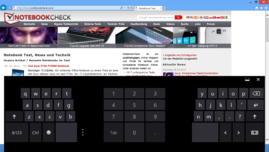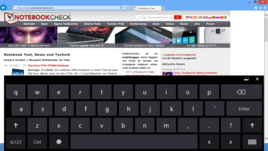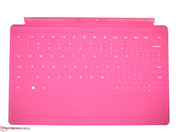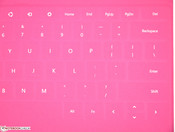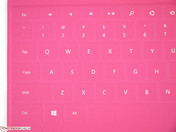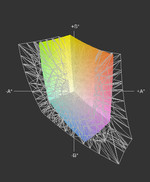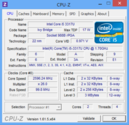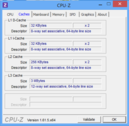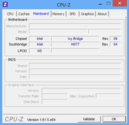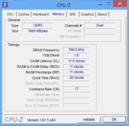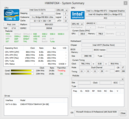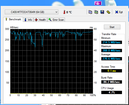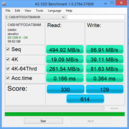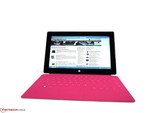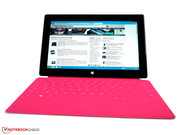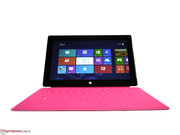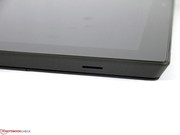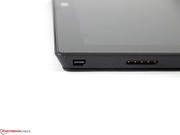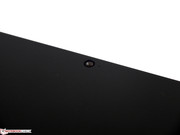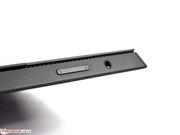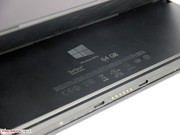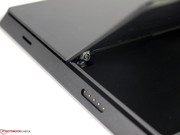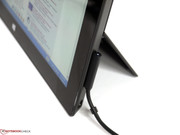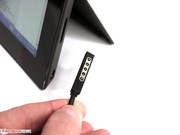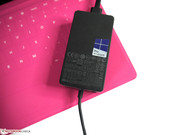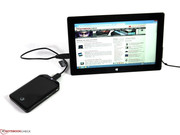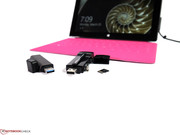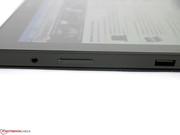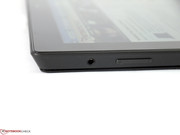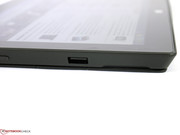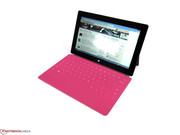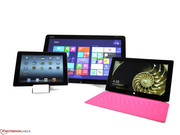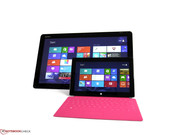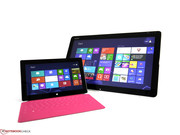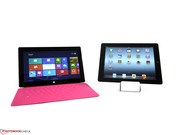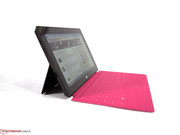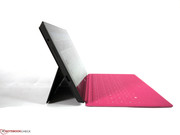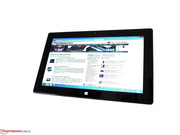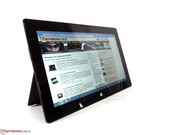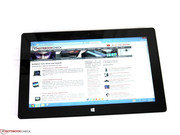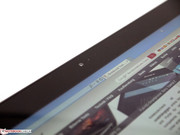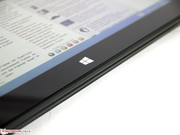Review Microsoft Surface Pro Tablet

For the original German review, see here.
The Microsoft Surface RT had a number of disadvantages regarding its relevance to the normal user. It was always going to be bogged down by incompatibilities with the existing software ecosystem developed around the X86 version of Windows 8. The Surface Pro is the device that is similar to the Windows RT tablet but uses the established Intel processor technology. The advantages are abundantly obvious: Windows compatible software and hardware can both be used without problems, in the same way as other Windows PCs, which circumvents the requirement for additional accessories or to wait for custom applications. Apart from this, the available hardware including everything from a hard drive to a shared printer or a DVB-T receiver can be used without any compatibility issues. This means that development and user costs are low for this device.
Right now, the Microsoft Surface Pro isn’t available in Germany and the website does not mention any date of availability. For the purposes of this review we used a US model with a storage capacity of 64 GB. The other option available for sale is the 128 GB version. We can only speculate on the price of the device when it is made available in Germany and we estimate it to be around the 800 Euros (~$1050) mark.
Case
The device is mostly edges and sharp corners that make it stand-out among other devices with the same form-factor. The magnesium alloy case is well made and the individual elements have been assembled with precision. The rigidity of the case is very good, and can be directly compared to that of the iPad. The kickstand integrated into the back which allows the device to be propped up, proves itself to be very practical; although we need to point out that there is only one position possible.
The powerful hardware components and the material of construction contributed to the weight of the device which came out to be about 920 grams. This may be light enough for comfortable transportation in a sleeve or in a bag, but not for holding in one hand for anything longer than a few minutes. Our comparison device, the iPad 3 is almost 300 grams lighter at 650 grams, making it much more comfortable to hold in one hand. We expected the thickness of the device to negatively impact the user experience but we found it to be a decent form-factor to hold making it comfortable to use with one hand for at least short periods.
Connectivity
To make the device appeal to businesses, Microsoft has included the mini-Display port and the mini-HDMI port for external display connections. We were not able to check if the ports were able to output a higher resolution than 1080p as we did not have the appropriate monitor at the time of writing this review. The device does not include a Thunderbolt port. The USB port present was the faster USB 3.0 version which allowed us reach read speeds of 238 MB/s using a solid state external hard drive.
Under the Windows logo, there is a form of docking port that allows for the integration of an external keyboard if necessary. There are no other ports on the device. On the right side of the tablet, there is a somewhat smaller, but otherwise identical type of connector, which is intended for the power supply or the input pen. The power supply also has an integrated USB port (5 watts) for charging external devices such as smartphones and MP3 players.
Communication
Microsoft has incorporated a rare WLAN module from Marvell that features two antennae and is able to work on both the 2.4 GHz and the 5 GHz bands. This type of module is not normally seen on Intel based devices. In addition to this, the chip already supports the WLAN standard 802.11ac, and can theoretically transfer data at a rate of 867 Mbit/s. During practical use we were able to observe a good signal strength which didn't show any unusual behavior. Also integrated into the module are Bluetooth 4.0 and NFC chips. The two webcams both have a resolution of 1280 x 720 pixels, which should be sufficient for taking pictures of auction items or for video telephony with limited quality demands, but doesn't reach the quality provided by iPad & company to a large extent. A version of the Microsoft Surface Pro with a WWAN module is so far not on the horizon. In this case, users will have to rely on external devices such as a USB stick, WLAN router or tethering via a smartphone.
Maintenance
The case is not intended to be opened by the end users. The battery and all the other components are integrated and should only be changed by authorized service partners.
Warranty
Microsoft grants a manufacturer’s warranty of 2 years. Extensions to the warranty haven't been found by us so far, but could almost certainly be determined once the Surface Pro is available in Germany.
Input Devices
Touchscreen
The high resolution of the display provides the opportunity to display a larger amount of data compared to the iPad 3 and 4. From a user perspective this does however make the icons and symbols too small for reliable touch control away from the desktop; something which should be better with the input pen that would normally be included, but wasn't in the case of our private review sample. Alternatively, an increase of the icon size to 125 or 150 percent should ameliorate this issue. The adjustment is well supported by most applications, and provides for legible icons and menu options. The sharpness isn't quite as good as on the iPad though, and looks a little blurred. Otherwise, the display responds well to touch commands, has good gliding characteristics, and supports the usual multi-touch gestures such as zooming and turning.
On-Screen Keyboard
The display keyboard only has a curtailed selection of keys in its standard configuration, although this should still be enough for many tasks and also provides for relatively large key sizes. The keyboard can also be split into several parts, the size can be changed and it can also be moved. Additional keyboard layouts, including a complete set of keys can of course be selected depending on the requirements.
Our test model was provided with one of the two attachable keyboards. The Touch Cover (120 Euros/~$160) is a 3 mm thick plastic lid with a matte surface which reacts to touch input without any key movement. It is especially thin and light, and also serves as a protective layer for the display. After a short period of acclimatization to the Touch Cover we were able to work with it quite well. Instead of the haptic feedback you get with other keyboards, there is an acoustic confirmation via the speakers which lets you know whether the key press was successful or not. This may take some time to become accustomed to, but doesn't get annoying. The integrated Touchpad is very small and actually quite superfluous, since touch control on the display is considerably faster and easier. The Touch Cover increases the weight of the Surface Pro by 210 grams. Additional impressions can be found in the review of the Microsoft Surface RT.
An alternative provided by Microsoft is the Type Cover, which is endowed with real keys. This weighs approximately 50 grams, consists of hard plastic and costs 130 Euros (~$170). With a depth of 6 mm, it is somewhat thicker, but provides the conventional key feedback. Unfortunately, we weren't able to test the Type Cover for this review.
The input pen which is normally included with the standard delivery, attaches to the magnetic power input, and can therefore be attached to the case only when the power supply is not connected. Using a safety cord for the pen, as is often customary with business convertibles is not an option. The input pen supports the input determined by varying amounts of pressure, although this is not recognized by all the applications. The pen was not compatible with Photoshop CS6 but we found it to work with programs like SketchBook Pro 6 and Art Rage 4. The stylus is not compatible with either the Dell Latitude XT3 not the HP Elitebook 2760p.
Display
The glossy 10.6-inch display has a resolution of 1920 x 1080 pixels meaning a pixel density of 207 dpi. This is very high and can lead to very small letters and symbols on the tiny display. The presentation is very sharp when using the native resolution, but long-term use could cause some users discomfort due to the strain on the eyes. The scaling can be changed in the appropriate options section but please do keep in mind that the change can lead to a loss in sharpness when higher font sizes are chosen.
The brightness of the Samsung panel was measured at nine different places on the display. The lower left corner is the darkest with a brightness of 337 cd/m², while the brightest area is at the center of the screen with a read of 371 cd/m². The varying levels of brightness cannot be recognized even with monochrome images. On average, the display reaches a maximum of 355 cd/m² while the illumination distribution lay at 91 percent. Since brightness can only be adjusted with a sliding controller, it is difficult to set a precise value. When the controller is set at about one third the brightness we measured was about 151 cd/m²- would suffice for use indoors with a matte display in most cases. In order to trump the reflections however, users will often have to set the brightness to a higher level.
| |||||||||||||||||||||||||
Brightness Distribution: 91 %
Center on Battery: 371 cd/m²
Contrast: 742:1 (Black: 0.5 cd/m²)
45.74% AdobeRGB 1998 (Argyll 3D)
66.2% sRGB (Argyll 3D)
44.23% Display P3 (Argyll 3D)
Outdoor users will have to be content with limited visibility of the contents in the same way as with most other tablets. The brighter the surroundings, the darker the display of the tablet, the more pronounced the effect. At least the maximum brightness of 371 cd/m² - is also available on battery power, and this is able to counteract the loss of legibility of the screen content to a certain extent.
The contrast ratio of 741:1 is significantly less than that of the Microsoft Surface RT (1079:1) which we have reviewed, but only marginally less than that of the iPad 4 (838:1). For practical purposes, the display has a very good level of contrast that differences can only be discerned with a direct comparison with other devices. Saturated colors and relatively deep blacks mean good presentation of pictures, videos and games. The covered color space is relatively small and doesn't even begin to approach the sRGB color space. While the greyscale presentation and color saturation can be improved with some calibration, this is only possible to a minimal extent in the case of the color accuracy due to the curtailed color space.
The IPS panel provides for very wide viewing angles and a very even representation of the display contents. Depending on the viewing position, users may however have to come to terms with slight discolorations and varying levels of brightness. Altogether, the display in the Microsoft Surface Pro is on the same level as the (consumer) competition, and doesn't exhibit any glaring shortcomings. Due to certain specific requirements, some business users could however end up being disappointed with the display. The only added value when compared to many other alternatives is merely the high resolution which allows for more productivity. The color space, contrast level, brightness and the glossy surface of the display are all characteristics that could be improved or changed depending on the parameter to better cater to the specific business user set.
Performance
The Microsoft Surface Pro comes with hardware components usually found in Ultrabooks. An Intel Core i5-3317U CPU with integrated Intel HD Graphics 4000 graphics, 4 GB of RAM and a fast storage device with a capacity of 64 GB promise a chart-topping performance. As an alternative, Microsoft should also provide a 128GB SSD version of the Surface Pro when it becomes available in Germany.
Processor
The Intel Core i5-3317U CPU is an ultra-low-voltage processor, which is geared towards low power consumption. The thermal design power (TDP) lies at 17 watts, and is reached by using relatively low clock speeds between 1.7 and 2.6 GHz. The technologies Turbo Boost and Hyper-Threading are both supported, and guarantee an optimized processing performance. With single-core applications, the maximum clock speeds can be reached, while the CPU is able to process up to four threads simultaneously with multi-thread applications.
When it comes to pure CPU benchmarks, the results were in line with our expectations and identical to those achieved by Ultrabooks using similar components. Cinebench R11.5 (64-bit), for example, ascribed scores of 0.9 (single-thread) and 2.39 (multi-thread) points. The Super Pi 32M calculation (single-thread) took 727 seconds, while the wPrime 1024M calculation (multi-thread) required 653 seconds. Altogether, the results lie in the upper range of comparable Intel Core i5-3317U values.
We tested the processing power by converting three MP3 files into the AAC format with iTunes. The pure CPU conversion of videos with MediaEspresso took considerably longer than other devices and probably isn't a task that should be performed by a business tablet all too often. Things move noticeably faster with Intel's Quick Sync technology which, by the way, also requires significantly less processing power (about 20 percent instead of 90 percent).
During maximum utilization of the CPU and GPU (Prime95 and Furmark), we witnessed an obvious reduction of the clock speed from 2.4 GHz to 1.2 GHz within a few minutes. During pure CPU utilization, the tool HWinfo showed minimum throttling from 2.4 GHz to 2.3 GHz. Both of these didn't have any discernible effect on the benchmark results or cause any slowdowns in the running of the tablet.
While battery powered, we weren't able to notice any additional performance impediments other than those described above. Exactly the same result of 2.39 points was achieved with the Cinebench R11.5 (multi, 64-bit) benchmark.
System Performance
With PC Mark 7, the Microsoft Surface Pro achieves an identical result as the Dell XPS 13 and the Acer Aspire S7-191 with 4813 points. A large portion of this can be attributed to the dualchannel mode of the RAM modules and the superfast solid state drive. The only improvements that can be done would be the upgrade to a better CPU-GPU combination and reducing the energy footprint. During practical use, most of the regular Windows programs can be used without any concerns. Only in the case of demanding 3D applications do considerable restrictions apply.
When it comes to the typical tablet benchmarks such as Geekbench or Sunspider, the Microsoft Surface Pro is in a league of its own as it is able to outperform all its rivals by a considerable margin.
| Sunspider - 0.9.1 Total Score (sort by value) | |
| Microsoft Surface Pro | |
| Apple iPad 4 | |
| Google Nexus 10 | |
| Microsoft Surface RT | |
* ... smaller is better
| PCMark 7 Score | 4813 points | |
Help | ||
Storage Device
Micron's Real SSD C400 is the storage device of choice and is connected to s SATA III port. The SSD can take full advantage of the bandwidth that is available. Sequential reads top out at about 500 MB/s while sequential writes are measured at about 87 MB/s. This is a limitation of the SSD firmware and the type of flash chip arrangement that has been used. The 128GB version of the Crucial SSD which is probably the same as the one adopted for the 128GB Surface Pro should be a little faster in this respect. Normal workloads don’t include much writing to the drive and there is also an issue of much of the storage space being occupied by the operating system. Following harsh criticism from users and the media, there is at least a note of caution on Microsoft's product website that warns of the fact that the system software takes up a sizable part of the storage space. Here is the math: Of the 64 GB in total, the user has about 26 GB available for programs and data. Expanding the storage capacity is possible with an SDXC memory card or via the USB 3.0 port with an external drive.
Graphics Card
Intel's HD Graphics 4000 has a clock speed of up to 1050 MHz in the Microsoft Surface Pro and is not subject to any throttling. During 3D Mark 11, a score of 626 points is achieved while 3D Mark Vantage produces a score of 2935 points. The performance during OpenGL Shading is about 5537 points in Cinebench R10, and 15.78 fps in Cinebench R11.5. These scores are average for a device of this class running Intel HD Graphics 4000. More results can be found in our comprehensive GPU benchmark list.
While running on the battery, the GPU runs at a frequency of only 350 MHz, which leads to a considerably lower result in Cinebench R11.5 of 6.67 fps. With the power connected we weren't able to detect any throttling on maximum utilization.
| 3DMark 06 Standard Score | 4951 points | |
| 3DMark Vantage P Result | 2935 points | |
| 3DMark 11 Performance | 626 points | |
| 3DMark Ice Storm Standard Score | 32347 points | |
| 3DMark Cloud Gate Standard Score | 3503 points | |
| 3DMark Fire Strike Score | 487 points | |
Help | ||
Gaming Performance
The gaming performance is sufficient to play leisurely PC games smoothly at low resolutions and reduced quality. This is only possible with the power adapter connected. During battery powered use, the reduced clock speed of the GPU takes its toll leading to a reduction of the frame rate anywhere between 30 to 50 percent depending on the game. Games specially developed for tablets such as Angry Birds Space or Galaxy on Fire 2 HD are always a viable option due to their minimal processing demands, and shouldn't pose a problem when running on the battery.
| low | med. | high | ultra | |
|---|---|---|---|---|
| World of Warcraft (2005) | 117 | 62 | 16 | |
| Diablo III (2012) | 46 | 25 | 21 | 14 |
| F1 2012 (2012) | 31 |
Emissions
System Noise
The cooling fan is operational at all times though the noise is only audible from being very close to the device with a low processing load - we measured about 29.5 dB (A). This is the scenario that is common when the tablet is running normal workloads that include basic productivity, Internet browsing and media consumption. While running several different tasks in parallel, the system noise increased to 32.6 dB (A), and increasing furthermore to 38.2 dB (A) with a medium processing load, finally exceeding 40 dB (A) when the processor and the graphics unit are both loaded. Particularly with medium and high utilization, such high noise levels have to be endured due to the type of hardware in use. ARM and Intel Atom processors are able to run at much lower TDPs that allow them to forgo cooling units, unlike the Core i5 processor in the Surface Pro, which keep noise levels down improving the user experience. But these processing units aren’t able to match the performance levels of the i5 processor. At least these noise levels in the Surface Pro are only noticeable when a substantial processing power is actually required.
Noise level
| Idle |
| 29.5 / 29.5 / 29.5 dB(A) |
| Load |
| 38.2 / 40.9 dB(A) |
 | ||
30 dB silent 40 dB(A) audible 50 dB(A) loud |
||
min: | ||
Temperature
The Microsoft Surface Pro always feels warm. Regardless of whether it is subjected to a low processing load or fully utilized, the difference only amounts to a few degrees Celsius. With a minimum of approximately 30 °C and a maximum of just over 40 °C, the surface temperatures never become unpleasant. The cooling system is conceived for working as silently as possible with a low processing load, while not allowing the internal components to get too hot with a high processing load resulting in relatively constant case temperatures.
(±) The maximum temperature on the upper side is 40.3 °C / 105 F, compared to the average of 35.4 °C / 96 F, ranging from 19.6 to 60 °C for the class Convertible.
(±) The bottom heats up to a maximum of 40.6 °C / 105 F, compared to the average of 36.8 °C / 98 F
(±) In idle usage, the average temperature for the upper side is 33.2 °C / 92 F, compared to the device average of 30.3 °C / 87 F.
(±) The palmrests and touchpad can get very hot to the touch with a maximum of 39.4 °C / 102.9 F.
(-) The average temperature of the palmrest area of similar devices was 27.9 °C / 82.2 F (-11.5 °C / -20.7 F).
Speakers
The audio reproduction is suitable for basic tasks which is also the case with most other tablets. Concentrated in the high frequency range with little mid-range or bass frequencies, the speakers should suffice for watching short videos online. Substantially better audio quality is achievable with the aid of headphones, which are more or less obligatory in public areas such as trains or waiting rooms in any case. External speakers can also be connected via Bluetooth, USB or the 3.5 mm jack.
Energy Management
Power Consumption
The power consumption (measured from the power supply) is substantially higher than those of other conventional tablet PCs. With a minimum of 8 watts and a maximum of 43.2 watts, the values are familiar to us as they are about the same obtained from the current crop of Ultrabooks such as the 13 inch Asus Zenbook Prime UX31A. In order to achieve half-decent battery runtimes in spite of such high power consumption, Microsoft has included a 42 Wh battery in the Surface Pro. There is no way to add to this capacity at the moment. Any maintenance tasks must be done at an authorized service center.
| Off / Standby | |
| Idle | |
| Load |
|
Key:
min: | |
Battery Runtime
With the Battery Eater Readers Test (maximum possible battery life, minimum display brightness, wireless modules off, power saver mode), the battery falls just short of the 7-hour mark. The Microsoft Surface RT for example, is able to hold out for more than twice this time despite its smaller battery. During the more realistic WLAN test (power saver mode, approx. 150 cd/m² display brightness, wireless modules on), the battery life falls to about 5 hours - which is about 4 hours less than the result achieved by the Surface RT. With the Battery Eater Classic Test (minimum possible battery life, maximum brightness, everything on, high performance profile), which more or less represents continuous conversion of audio or video files, our test device ran out of juice after 1:33 hours.
Verdict
Microsoft's attempt to combine a tablet and an Ultrabook has been a success in almost every respect when it comes to the Surface Pro. The significantly improved processing power which is effectively identical to that of an Ultrabook, comes at the expense of a few significant disadvantages though.
In terms of the mobility, a comparison to the established tablet rivals reveals a considerable amount of compromise, while the battery life is about half as long and the weight is almost double. The actively cooled system is another issue as the Surface Pro is a pretty noisy device compared to the other tablets in its class.
But, users are able to put to use a full-fledged version of Windows 8, which allows you access to the full gamut of applications that are applicable to x86 hardware. Accessories are easy to find and are light on the wallet. The limited number of ports and the low graphics performance are some disadvantages that many might be able to overlook if they are looking for a tablet that is able to offer the same performance as an Ultrabook.
Many buyers would be definitely looking at the 128 GB option of the Surface Pro as a lot would run out of the storage space available on the 64 GB version. There is no way that a user can increase the storage capacity and there is also some performance issues associated with the capacity that needs to be left free on the SSD to enable its maintenance functions.
The display doesn't provide anything out of the ordinary with the exception of the Full-HD resolution. Brightness, contrast and of course, the glossy display surface are standard for this class of device. Along with the obligatory touch surface, there is provision for control with an input pen which is included with the standard delivery (not tested here) and should prove to be better suited to some tasks.
The Touch Cover keyboard which also serves as a protective cover for the display, improves the typing experience considerably when compared to using the on-screen keyboard. On the other hand, the additional weight means that the device is almost as heavy as an Ultrabook and mobility is furthermore hampered by an additional 200 grams.
Altogether, buyers of the Microsoft Surface Pro will received a potent tablet with unique characteristics for an estimated price of at least 800 Euros. Mobility, storage capacity and the system noise are parameters that a user needs to keep in mind when considering that this is a first-generation device.








